
Concept explainers
Sketch the budget constraint.
Explanation of Solution
Maximum unit of good Y (0 unit of good X is purchased) that a person can purchase with the given income and price can be calculated by using the following formula:
Substitute the respective values in Equation (1) to calculate the maximum unit of Y that can be purchased.
The maximum unit of Y is 200 units.
Maximum unit of good X (0 unit of good Y is purchased) that a person can purchase with the given income and price can be calculated by using the following formula:
Substitute the respective values in Equation (2) to calculate the maximum unit of X that can be purchased.
The maximum unit of X is 50 units.
Option (a):
Figure 1 shows the budget constraint of case “a”.
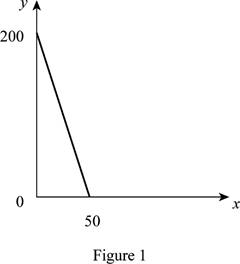
In Figure 1, the vertical axis measures the price of good Y and horizontal axis measures the price of good X. The downward sloping cure is the budget constrain of the household.
Option (b):
The maximum quantity of good X and Y is 25 and 40 respectively that is obtained by using Equation (1) and (2).
Figure 2 shows the budget constraint of case “b”.
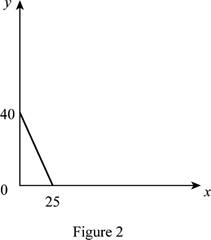
In Figure 2, the vertical axis measure price of good Y and horizontal axis measures price of good X. The downward sloping cure is the budget constrain of the household.
Option (c):
The maximum quantity of good X and Y is 40 and 5, respectively that is obtained by using Equation (1) and (2).
Figure 3 shows the budget constraint of case “c”.

In Figure 3, the vertical axis measures the price of good Y and horizontal axis measures the price of good X. The downward sloping cure is the budget constrain of the household.
Option (d):
The maximum quantity of good X and Y is 20 and 50, respectively that is obtained by using Equation (1) and (2).
Figure 4 shows the budget constraint of case “d”.
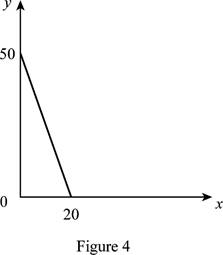
In Figure 4, the vertical axis measures the price of good Y and horizontal axis measures the price of good X. The downward sloping cure is the budget constrain of the household.
Option (e):
The maximum quantity of good X and Y is 4 and 6, respectively that is obtained by using Equation (1) and (2).
Figure 5 shows the budget constraint of case “e”.
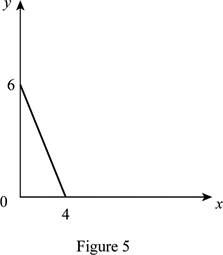
In Figure 5, the vertical axis measures the price of good Y and horizontal axis measures the price of good X. The downward sloping cure is the budget constrain of the household.
Option (f):
The maximum quantity of good X and Y is 24 and 4, respectively that is obtained by using Equation (1) and (2).
Figure 6 shows the budget constraint of case “f”.
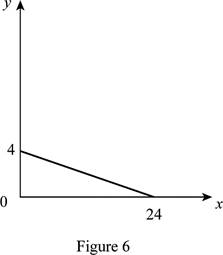
In Figure 6, the vertical axis measures the price of good Y and horizontal axis measures the price of good X. The downward sloping cure is the budget constrain of the household.
Option (g)
The maximum quantity of good X and Y is 4 and 24, respectively that is obtained by using Equation (1) and (2).
Figure 7 shows the budget constraint of case “g”.
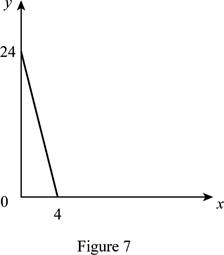
In Figure 7, the vertical axis measures the price of good Y and horizontal axis measures the price of good X. The downward sloping cure is the budget constrain of the household.
Budget constraints: Restrictions imposed on household’s choices by the factors like wealth, income and price of product are termed as the budget constraint.
Want to see more full solutions like this?
Chapter 6 Solutions
EBK PRINCIPLES OF MICROECONOMICS
- Which of the following could explain the change in the budget line from A to B? Y 10Barrow_forwardRaymond consumes meatloaves and pineapples. He has decided that hismonthly budget will be $1500. Suppose that one meatloaf costs $375, while onepineapple costs $150.i. What is the expression for Raymond’s budget constraintarrow_forwardCoffee 60 80 Tea An individual allocates $180 a month for spending on coffee and tea at their workplace. Using the budget constraint appearing above, the price of tea is:arrow_forward
- please explain the theory of marginal utility. Please include a particular product or service you use and how marginal utility applies. Search entries or author Don't copy from privious answerarrow_forwardThe graph represents a budget constraint showing the purchases of Good X and Good Y. If the price of good X falls, then budget constraint will move from budget constraintarrow_forwardMauricio has a circus act, and he has a budget of $720 to spend on monkeys and unicycles. The cost of a unicycle is $120, and the cost of a monkey is $90?arrow_forward
- Part 1: Budget Constraints Suppose you have $48 to spend on the two items in the graph below. Q books 5 3 A 1 2 4. 6 8 Q movietickets If movies cost $8, which line represents your budget constraint? [Select] If books cost $12, which line represents your budget constraint? [ Select ] Suppose your budget constraint shifts from line C to line A. What has occurred? [ Select ] Suppose your budget constraint shifts from line A to line B. What has occurred? [ Select ]arrow_forwardJody has $360 to spend on her summer vacation. She decided to use the moneyon trips to the zoo and on tickets to the movies. Her original budget constraintis shown below. Let X represent movie tickets and Y represent trips to the zoo.i. What is the equation of the original budget constraintarrow_forwarddraw the budget constraint for a person with income of $ 1000 if the price of pepsi is $5 and the price of pizza is $10 what is the slop of their budget constraintope of their budgetarrow_forward
- Complete the paragraph by filling in the blanks based on what you have learned from the lesson. Choose your answer from the words below. INCREASES PRICE SCHEDULE TECHNOLOGY LESSER PREFERENCES SUBSTITUTE PRODUCT CURVE WEATHER GOVERNMENT POLICY SEASONAL PRODUCTS SURPLUS SHORTAGE I learned additional lessons in Applied Economics. This week I learned about the law of supply which states that when the increases the quantity of products that the producer is willing to sell. and the law of demand which states that the higher the the the demand. To be able to analyze the demand and supply I can use the demand and supply and the demand and supply graphical representation of the relationship of price and quantity. I also understand that aside from price, there are other factors that may affect the supply some of these are and There are also factors that may affect demand like and I can say that it is better if there is market equilibrium which means that the quantity supplied and the quantity…arrow_forwardSimone's initial budget constraint is defined by the following equation: $21=$3×Qburgers+$0.50×Qsoda$21=$3×Qburgers+$0.50×Qsoda If the price of the burgers decreases from $3.00 to $1.50, and the price of soda increases from $0.50 to $0.80. What is the maximum number of burgers she can purchase?arrow_forwardplease explain the theory of marginal utility. Please include a particular product or service you use and how marginal utility applies. Search entries or author please l want new onearrow_forward

 Economics (MindTap Course List)EconomicsISBN:9781337617383Author:Roger A. ArnoldPublisher:Cengage Learning
Economics (MindTap Course List)EconomicsISBN:9781337617383Author:Roger A. ArnoldPublisher:Cengage Learning Economics Today and Tomorrow, Student EditionEconomicsISBN:9780078747663Author:McGraw-HillPublisher:Glencoe/McGraw-Hill School Pub Co
Economics Today and Tomorrow, Student EditionEconomicsISBN:9780078747663Author:McGraw-HillPublisher:Glencoe/McGraw-Hill School Pub Co



